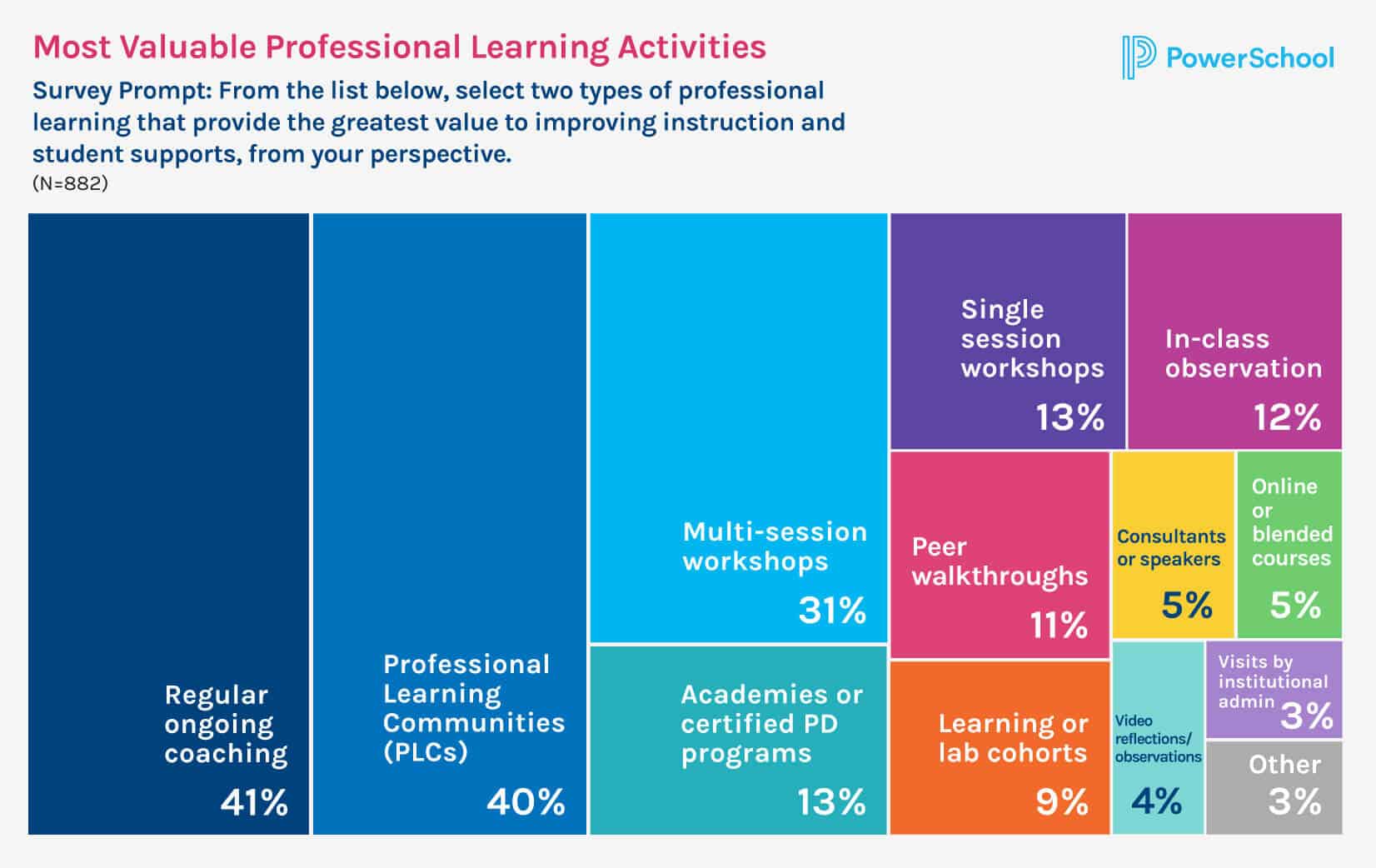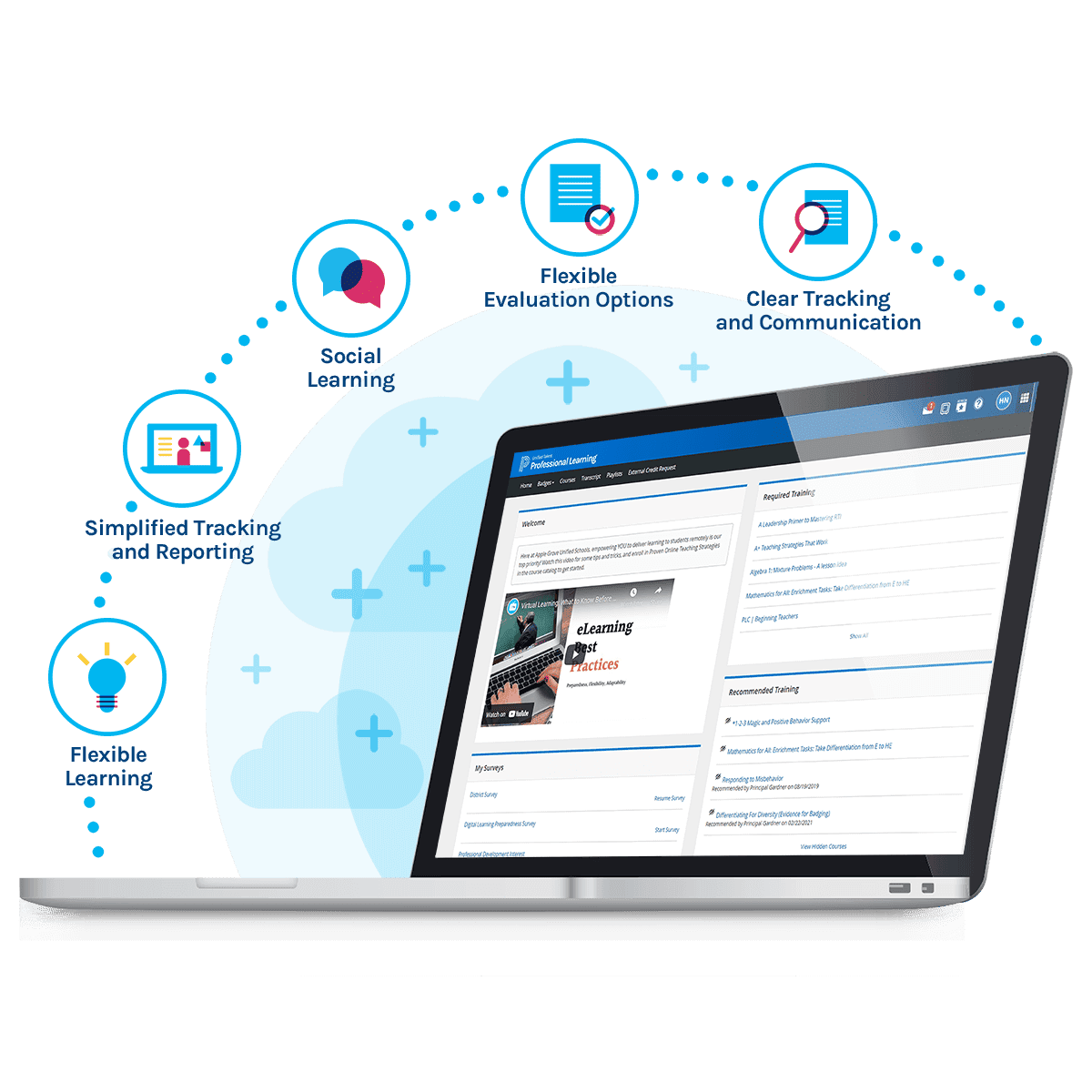Collaborative, ongoing PD works best
Collaborative, ongoing forms of professional development (PD) for teachers came out on top in our 2022 Education Focus Report: Top District Priorities and Shifts in PK-12 Education . In identifying activities that provide the greatest value, survey respondents from across the U.S. overwhelmingly chose working together, either with a mentor or with peers, over traditional “sit-and-get” methods of professional learning, like listening to speakers or consultants.
Working together and committing more time to PD topics stand out as core aspects of the top three selections in our survey. These results make sense considering that teachers need to make the most of their time when it comes to PD. They already have a lot on their plates these days, and they want to devote as much time as they can to supporting their students. Their time is valuable, so they want to spend it on meaningful, applicable activities rather than sitting through speaker sessions or courses just to check a box for compliance reasons.
Here’s how educators ranked their top PD choices:
Providing teachers with PD they find most helpful and worth their time can help drive engagement, educator effectiveness, and ultimately student success.
Provide regular, ongoing coaching for better PD engagement
Educators chose regular, ongoing coaching as their top choice in valuable PD at 41%. The survey doesn’t specify, but coaching could be done by a curriculum and instruction leader, administrator, or principal. Experienced teachers could also serve as mentors. What stands out in this answer is respondents’ clear desire for personalized PD that helps them continuously improve and build their skills over time.
Evaluations can play a core role in providing regular, ongoing coaching. Offering check-ins between formal evaluations is a great way to deliver more consistent feedback and help teachers realize their progress throughout the school year. When it comes to annual evaluations, turning these into growth conversations can help you deliver value beyond checking a box for compliance.
The Danielson Group’s Framework for Teaching (FFT) is one example of a growth-focused approach to evaluations. It uses a rubric-based model that focuses on critical teaching skills. It also lets administrators personalize the evaluation experience with opportunities for self-assessment and collaborative inquiry. Together, administrators and teachers can cover the entire teaching experience, creating chances to address bigger challenges like stress, burnout, and career stagnation.
How an Ohio district maintains above average teacher retention
Supportive teacher evaluations directly contribute to the high retention rate at Olentangy Local School District in Ohio, says Director of Human Resources Nancy Freese. “The process is about dialogue and collaboration,“ she explains.
Freese’s district uses PowerSchool Perform to incorporate research-based rubrics and narrative feedback into each evaluation. The software is part of the PowerSchool Educator Effectiveness Cloud, a holistic solution for teacher support, growth, and career development. The technology let’s principals and administrators personalize each teacher evaluation, no matter how long they’ve been working with a particular teacher. That’s because they have historical data to review, even if the evaluator is new to the district or a teacher has moved from one school to another. They can look at clear rubric scoring and narrative feedback from previous evaluations, then reflect on success and how to address new or ongoing challenges.
The results speak volumes. Freese says recent exit interviews reveal that they’re not losing teachers to stress and burnout—when teachers do leave the district, it’s for other reasons like a family situation. She chalks their success up to one key factor: “Our teachers feel supported.”
Offer collaborative teacher PD through professional learning communities (PLCs)
Teachers chose professional learning communities (PLCs) as a very close second in our survey at 41%. This highly collaborative PD approach brings groups of educators together to share ideas, learn, and grow. Rather than the mentor- or supervisor-led model in the coaching approach, PLCs offer peer-to-peer collaboration. Of course, more experienced educators and those with specific expertise can take the lead on a topic, but the overall idea is that members all bring value to the table and can freely chime in to help each other and elaborate on ideas.
PLCs can meet in person and/or in an online format. Technology offers the flexibility to expand PLC membership across a district, state, or even globally. Including a wider diversity of membership outside of a single school introduces wider perspective and the chance to spread effective ways to address challenges.
Learn more about creating PLCs in this short PowerSchoolTV video.
Create meaningful PD engagement with multi-session workshops
Multi-session workshops ranked third our survey of valuable PD types. At 31%, this format still outpaced more traditional “sit-and-get” forms of professional learning like academies and certified programs, consultants, or single speaker sessions. We take this result as an indication that teachers want the time to digest and better understand PD topics. Multi-session workshops, as opposed to a single session or a one-off course, allows learners to think about a topic between sessions, then come back with meaningful questions or even further research to inform their contribution to group discussions. In essence, this format allows for more engagement and stronger takeaways for applying the skills in real-life settings.
Districts looking to create more opportunities for collaboration can look at multi-session workshops as a step in the right direction. Existing programs give you a learning structure, calendar, and an instructor right off the shelf. A logical next step could be developing PLCs to enable educators to take their collaborative momentum to other topics.
Create professional development opportunities that focus on educator collaboration
Whether it’s personalized one-on-one coaching, a mentor program, or group discussions, collaboration gives educators time to dig into topics, share ideas, explore new ways to address challenges. They can also discuss what’s not working and make changes as necessary—flexibility not available through traditional “sit-and-get” learning. Educators benefit from working together just like their students.
Offering the types of PD educators find most valuable helps them make faster progress toward their goals and get more for their valuable time. In teaching, time is a premium. Classroom teachers want to devote as much of their workday as they can to their students, so PD needs to pack a lot of punch to feel like it’s worth their time. Making it a meaningful, engaging experience helps them become the strong teachers students need while driving career satisfaction. The result can be more teachers who find a long, fulfilling career in your district.
Explore the PowerSchool Educator Effectiveness Cloud
See our complete solution for helping educators thrive.
Learn More



